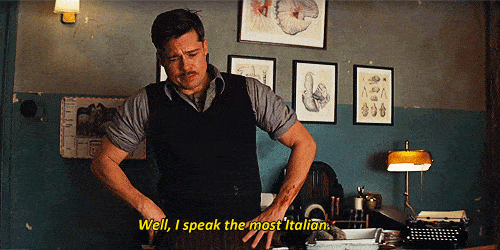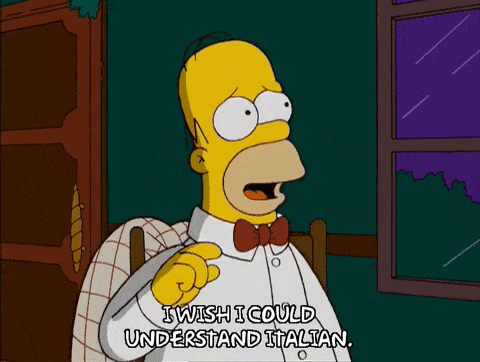Learning how to express your gratitude is important. if you didn’t know how to say “thank you” in English you would come across as rude in your daily life. You probably wouldn’t have any friends and your waiter would never slide you any breadsticks on the house. Saying thank you in Italian is no different.
Much like any culture, Italians emphasize expressing gratitude and showing good manners. Italians like to say ‘Grazie‘ as a sign of good manners and they like to say it every chance they get. Although this simple word is perfectly acceptable there are so many other expressions that will make you sound like the most polite person in Italy.
In this article, we will explore the 8 best ways to say thank you in Italian according to the varying degrees of gratitude as well as how to respond to the gratitude you receive.
Once you feel confident in saying thank you in Italian try learning how to say thank you in French. In fact why not just learn all the romance languages?
Without further adieu, here are 8 ways to say thank you in Italian.
Difference between Grazie and Grazia

These two words seem interchangeable but you are forewarned, even though they look the same, they are two different words with different meanings. Allow us to explain: “Grazie” is The Italian word for “thank you”. It is also the plural form of “Grazia” but you cannot use “Grazia” to express gratitude. “Grazia” actually means “grace” and has nothing to do with thank you. When spelled with a capital it becomes a popular name in Italy translating to the same English name “Grace.” These are homonyms so it’s understandable why it can be so confusing.
Just so that it is said. Italian vs Spanish can be similar but the Spanish “gracias” should never be used when speaking Italian. It is not Molto bene.
To put it simply, Even if you’re being grateful for a single thing you cannot use Grazia to express your gratitude.
You can’t go wrong with saying “Grazie”; it can be said with just about any audience. It is straightforward and a catch-all that covers both formal and informal situations. If you are blank on any other terms of gratitude or unsure of how gracious you should be, then saying “Grazie” is a perfectly acceptable term to use.
How to say thank you in Italian

As we’ve established above, “Grazie” is a simple option that will never fail, regardless of the region or dialect. The only correct pronunciation for thank you in Italian is “graht-see-eh “. make the mistake of omitting the “e.”
It can be used in both formal and informal situations and can be used to thank one person or many people at a time.
Not only can you use it to say thank you in Italian, but also as a way to accept or refuse an offer. In English we say “yes, please” or “no, thanks” to accept or refuse an offer, however in Italian “Grazie” is used in both situations: ‘si, grazie’ and ‘no, grazie.’
Vuoi una fetta di torta? – Would you like a piece of cake?
No, grazie. – No, thanks.
Posso offrirti un caffè? – Can I buy you a coffee?
Sì, grazie! – Yes, please!
Like every language, words and terms have layers to their meaning. “Grazie” is no different. “grazie” can also be used ironically in reaction to a statement’s obviousness, it can be seen as the English equivalent of “of course”, and “no wonder”. This is something non-native speakers aren’t familiar with but will make a big difference in impressing a native Italian speaker.
Stefano si è comprato una Ferrari? Grazie, con tutti i soldi che ha!
Stefano bought a Ferrari?! – No wonder with all the money he has!
How to say thank you very much in Italian

When ‘grazie’ is not enough for what you’re trying to express, try using “grazie mille” pronounced graht-see-eh mee-leh. It’s natural to progress from just using the term “grazie” to something with a bit more oomph. That’s where “grazie mille” comes in. Mille may sound similar to the English word “million” but according to the Italian number system its actual meaning is “one thousand”. If we translate that to English the phrase means “a thousand thanks”.
Next time you get invited to your Italian friend nonna’s house for dinner you can say “Grazie mille per la cena. Era buonissima!” which translates to “Thank you very much for the dinner. It was delicious.”
How to say thank you a million in Italian

What do you say when thanking you so much isn’t going to cut it? Try saying ‘grazie infinite’ (graht-see-eh een-feen-eet-eh). This translates to “infinite thanks” or can be considered to mean thank you a million. Take note that in English it is standard to not pronounce the ‘e’ in “infinite” but in Italian, the ‘e’ is always pronounced.
when someone has done something special or impressive for you and you need a way to express your deep gratitude with strong emotion then this is the expression you should use. It should be noted that it can sound slightly over the top in a casual chat with family or friends as it is a bit more ‘flowery’ than “grazie mille”.
Grazie infinite per avermi aiutato.
Thank you so much for helping me.
How to say thank you for everything in Italian

Has someone repeatedly assisted you with something? Maybe they helped you to the train station or helped facilitate your work. Use the term Grazie di tutto (Graht-see-eh di too-toh) to thank them.
It means ‘thanks for everything’ and should be used to emphasize the fact that you truly appreciated what someone did for you and his or her commitment. This term can also be used in both formal and informal situations.
Grazie di tutto, a presto, arrivederci!
Thank you for everything, see you soon, bye, bye!
How to say “thank you for…” in Italian

If you’re trying to show gratitude for something more specific you can add more flair than just ‘grazie’ there are two ways to do it. you can either use “grazie di…” or “grazie per…”. These are followed by either a verb in the past infinitive or a noun.
There are formal and informal ways of coming across. In the most basic sense, to make a sentence formal you need to replace “tuo/a” with “suo/a.”
Informal: Grazie mille per il tuo aiuto – thank you for your help
Formal: Grazie mille per il suo aiuto – thank you for your help
Grazie per il regalo – thank you for your gift
Grazie tante per la tua pazienza – thank you for your patience
Grazie di avermi scritto – thank you for writing to me
Grazie di essere venuto – thank you for coming
Formal Way of saying thank you in Italian

As much as these terms we’ve just learned are useful, there will be circumstances where a more formal tone is appropriate. Knowing these terms can make or break the situation you are faced with so they are vital to making a good impression.
During formal and informal situations there are a lot of different pronouns you can use. If you’re talking to a singular person you have just met or perhaps an older person you would use ‘la ringrazio tanto’ (la reen-graht-see-oh tahn-toe). If you’re talking to more than one person and would like to say thank you to a whole group of people you would use ‘vi ringrazio tanto’ (Vee reen-graht-see-oh tahn-toe).
La ringrazio – Thank you (singular)
Vi ringrazio – Thank you (plural)
Le sono molto grato/a – I am grateful to you (singular)
Vi sono molto grato/a – I am grateful to you (plural)
How to respond/say you are welcome in Italian

As much as you are bound to say thank you in Italian you are also bound to be thanked. So how do you respond? In English, there are a plethora of ways to say you’re welcome in Italian is no different but for the sake of time let’s look at 3 of the most common ways to say you are welcome in Italian.
The classic answer to the word grazie is the word prego (pray-go). This can be said to one person, or a group of people and works in both formal and informal situations.
Mi passi il sale, per favore?
Ecco a te!
Grazie!
Prego!
Would you pass me the salt, please?
Here you are!
Thanks!
You are welcome!
It can also be used as an invitation for someone to do something:
prego, si sieda – please, have a seat
If you want to use a different word to prego you can use ‘di niente’ or ‘di nulla’ which means ‘its nothing.’ It can be used if you want to minimize the importance of what the person is thanking you for or letting them understand that it wasn’t a hassle for you.
Grazie mille per il tuo aiuto!
Di niente, quando hai bisogno, chiamami.
Thank you so much for your help!
It was no problem at all, call me when you need me.
Finally, we have ‘Figurati’. The closest equivalent to English would be “don’t mention it”. This phrase is used a lot in Italian and is used in both informal and formal settings. It simply translates into the humble idea that the kindness extended costs the speaker nothing and does not deserve notice.
Giacomo, grazie per essere andato a prendere Greta a scuola.
Figurati, passavo proprio di lì quando mi hai chiamato.
Giacomo, thank you for picking Greta up from school.
Don’t mention it, I was just around there when you called.
Grazie, you’ve made it

You now know how to say thank you in Italian and how to properly respond to someone who is thanking you. Whether it’s in a formal or informal setting you’re equipped to be the most courteous person in the room.
But why stop there, trying to learn how to say thank you in French? Heck, why don’t you try learning how to say thank you in Turkish? Whatever you decide if you’re interested in learning more there are a ton of resources at your disposal.
As always we stand by the fact that the best way to learn Italian is by finding a professional tutor to guide you in the right direction.
To date, AmazingTalker has matched over 2 million students to professional tutors completely personalized to their needs. They can do the same for you.
















